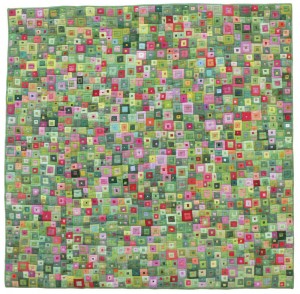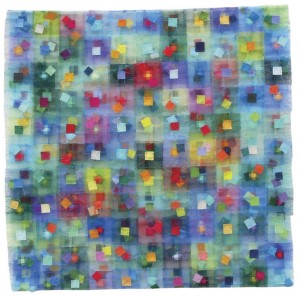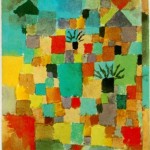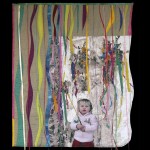We received our copy of Masters: Art Quilts, Volume II a while ago but have yet to review it on our blog. Of course, lots of people have beaten us to the punch because it’s such a rewarding find: good quality photography, well chosen photo details, and helpful essays on 40 accomplished artists. Martha Sielman did a great job putting this volume together. Instead of trying to outdo what others have already done, we thought it might be interesting to delve into a few of the artists in the context of questions that arise in our own work. Today the topic is Beatric Lanter. When I first opened the book, it just happened to open to page 201 and Lanter’s “Wiese” (2007).

I marveled a while at this piece, intrigued by the way Lanter worked the traditional log cabin block into a harmony of color that indeed gave me the sense of looking at a meadow. Then I realized that I had just read the title and absorbed its meaning without consciously noting the title was in German. (Both Deb and I speak German – that’s how we met – in German Club!) Well, then I got all nostalgic for the amazing central European meadows I had seen many times (live and in photos), with variations of green and eye-popping flowers dotting the undulating meadows. You see, when you grow up in California, the Golden State, you get excited about green meadows. The point of the story is that I came to see the piece completely differently because the title was in German, and that got me to wondering if the title was left in the original for a reason (Lanter has previously exhibited in the US using English titles, and one piece in Masters II is titled in English).
Just how important are titles anyway? When you run across a work called “Untitled,” do you wonder whether the artist expressly wanted to be vague? (I’m not talking here about really old works or recently found works by masters but works by modern artists who know full well that titles help in identification.) I got to thinking of how often I look at an artwork and then see what the title tells me about the piece. Here’s Lanter’s “Geschenk” (2002).

If you don’t know what the title means, what do you see? Before I read the title, I saw confetti and a party, but after reading the title, which translates into “Present/Gift,” I started focusing on the sheer fabric, the gift of the layers, and the joy of giving. (I won’t go into the whole “gift”-in-German-means-poison dilemma!!) When you check out the book, look for “Hinten II” (2007) and “Hinten III” (2008). Once you realize “Hinten” means ‘behind,” you see that Lanter has deliberately used the reverse side of her piece as the front (and I defy any painter to do the same!). By naming these two pieces “Behind,” it seems as if Lanter is asking the viewer to think about the other side of everything; there are two sides to every story.
Looking at Lanter’s work got me to thinking about another Swiss artist, Paul Klee (1879-1940). I think it was Lanter’s colors that reminded me of Klee, but I also know he painted a lot of abstracts. Here’s Klee’s “Südliche Gärten” (1919).

The words “Südliche Gärten” (“Southern Gardens”) are actually written on the bottom left-hand side of the watercolor, so there shouldn’t be any confusion, right? Well, if you google this painting, you’ll more often than not find it under “Tunisian Gardens.” I don’t know how or when the words changed, but now they clearly ask the viewer to think of Tunisia. Yes, Klee traveled to Tunisia and completed this painting while there, but why didn’t he name the painting “Tunesische Gärten”? If I were in academic mode, I would scour his letters to see if he referred to this painting as such, but let’s leave Klee at his words on the painting. The gardens are Southern and non-specific – does that not allow for more associations on the part of the viewer?
This brings us to to the Pixeladies and the issue of titling your artwork. There are two of us, so you can imagine the back and forth that goes on when we title our work. Here is one piece we did, “Finally: A Quilt for Tizia” (2008).

We were making this quilt for the daughter of Deb’s friend. She had already made quilts for the two older sisters but was dragging her feet on this last one. Well, when we finally finished the darn thing, we thought, “Endlich: Ein Quilt für Tizia!” Yes, we actually titled it in German since Deb’s friend is German. We had the quilt critiqued, and one comment we received was that the title didn’t help them understand the quilt, and that if we were going to title the work, that was one way to help convey meaning. So, our inside joke remained just that. It took the members of the critique panel a while to notice the two other girls in the photo. We had wanted Tizia’s sisters to function as guardian angels (well, it was our way of using a photo of all three girls since Deb didn’t have a photo of Tizia alone), but no one got that until we mentioned it. Maybe it might have helped if our title had been different. So, what do you think? Should we rename this quilt? If so, what do you suggest?

4 responses to “Beatrice Lanter, Masters II, and Titling Artworks”
Keep the title! I enjoyed reading all of this, though it’s late, I’m bleary-eyed, and I should have waited for a rested brain in the morning.
Love the quilt, love the title.
Thanks! We already made the label, so we’ll think long and hard about changing the title. However, we are rethinking all of our new work in terms of titles.
Titling work is one of the hardest things that I know. I have a very difficult time trying to descide on a name. I do think that the title can help to explain something about the idea behind a particular quilt.
We agree! That may be why we end up “discussing” our titles for so long. Two heads may be better than one, but they certainly can butt up against each other every now and again!